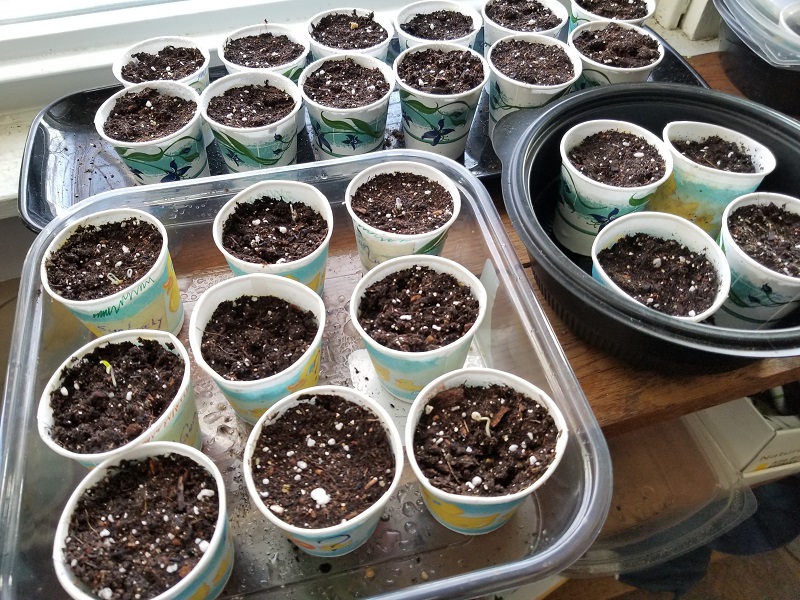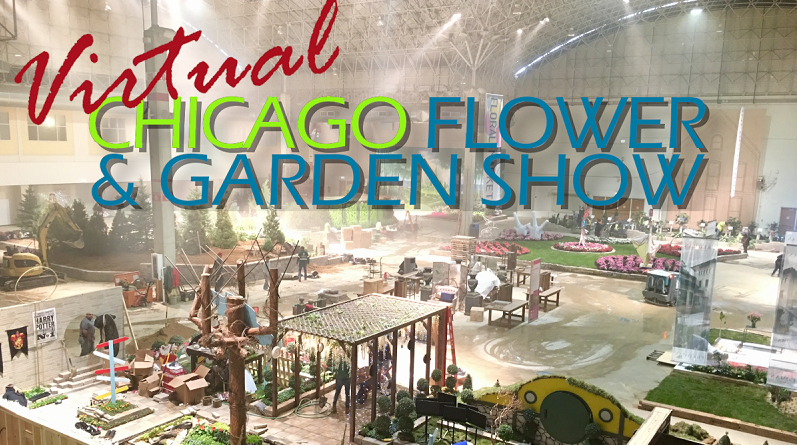The Virtual Chicago Flower & Garden Show
Podcast: Play in new window | Download (Duration: 1:34:55 — 42.7MB)
Subscribe: Apple Podcasts | Spotify | Android | iHeartRadio | Podchaser | Email | TuneIn | RSS | More
(March 22, 2020) Welcome to the Virtual Chicago Flower & Garden Show! This is what happens when the entire country is on the verge of being shutdown by an out-of-control virus. Last week, Peggy and I began broadcasting from our respective homes, as a measure of how seriously we take the COVID-19 pandemic. I will start this blog by saying two things. Stay home. Wash your hands. Not necessarily in that order.
But do stay home. If you think you are safe from being infected, you’re wrong. If you think you’re young and strong enough to withstand an infection, you’re wrong. If you think you won’t infect anybody else, you’re wrong. You can always get more information about COVID-19 from the CDC.
Meanwhile, today was the day that The Mike Nowak Show was scheduled to broadcast live from the Chicago Flower & Garden Show on Navy Pier. Obviously, with the State of Illinois under a stay-at-home order, that isn’t happening. But it doesn’t mean you can’t visit us on the radio or online. So, this morning, we hope you join us in our first hour for what we call the Virtual Chicago Flower & Garden Show.
Let’s get started.
Tony Abruscato, president and director of the Chicago Flower & Garden Show, will briefly explain what it’s like to try to find homes for hundreds of orphaned plants. He’ll talk about what it means to move forward with the show, and his work with the Get Growing Foundation and Plant Truck Chicago.
Then, Brekke Bounds from City Grange Garden Center talks about how to start your own seeds at home. Brekke She holds a B.A. in Environmental Studies, an M.S. in Sustainable Food Systems and is certified in Permaculture Design. Today, she provides information on choosing seeds, making or buying biodegradable pots, and how to care for your seedlings. Here’s the breakdown.
-

Our definition of hope. What equipment do you need? What’s an ideal set-up? What do you need to make do for now? There will be a quick lesson on making homemade paper pots.
- Choosing seeds: What should you start indoors now? What can you start with limited equipment? What’s good for beginners?
- Since we’ll also be streaming live video on Facebook and YouTube, she’ll show her own set-up.
- Tips, tricks, troubleshooting
By the way she says that she’ll have a blog post with more detailed information up on the City Grange website either Sunday or Monday.
Next up is Kasey Eaves from Vivant Gardening Services where she makes gardening with edibles, natives and pollinator plants approachable to area residents, restaurants, schools and more. Her subject for the Flower Show was going to be Perennial Edibles for Low Maintenance Gardens.” Right now, however, I’m happy just to know how to grow something to eat that will come back next year–regardless of the maintenance level.
Anyway, Kasey will take you through her favorite edibles that, with little work, can bring you years of harvest – including a few you will not find at the market. They include
- Self pollinating fruits like Juneberries (Amelanchier), currants, sour cherries and raspberries
- No fuss perennial alliums like elephant garlic and walking onions, shallots and chives
- Perennial herbs like thyme, oregano, sage, and sorrel
We might even get into more into exotic plants, such as rhubarb or horseradish!
We wrap up with Marcia Lautenan-Raleigh from Backyard Patch. By the way, the pronunciation of her last name is
LOU-ta-nen Raw-lee. Just sayin’. She promises a master class in blending herbs for cooking and tea. The segment will give you an introduction into identifying the specific essences of herbs and their flavors. We’ll talk about the flavors and scents of the herbs, and give you a few steps to create your own herb seasoning mixes and herb teas, including the best pairings of herbs with vegetables.
Marcia obviously knows her stuff. She says that her programs have been listed as a “Best of the Best” in the Northern Illinois Library Association. She is also a regular contributor to The Essential Herbal Magazine since 2008. To find out more about her 20 years of herb gardening experience, check out her blog.
Well, that’s the Virtual Chicago Flower & Garden Show. It’s not exactly the same as seeing the exhibits and being downtown in person. But, as I always say, when life hands you garlic, make a pungent herbal infusion.
Are farmers markets safer than supermarkets?
As we mentioned earlier, the State of Illinois is under a stay-at-home order due to the rapid spread of the coronavirus. As of this writing, that makes about 75 million people across the country. But that will change tomorrow and the next day and the next day and the next day. Unless you’re a major media operation, it’s almost impossible to keep up.
That said, we are doing our best to report what we know, especially when it comes to local food and outdoor areas. If your email inboxes are filled with COVID-19 messages, so are ours. This week alone, we heard from Chicago’s Advocates for Urban Agriculture, the Chicago Farmers Market Collective, Illinois Stewardship Alliance, Illinois Farmers Market Association, and smaller entities like The Plant, Sugar Beet Food Co-op and Logan Square Farmers Market, which has a great list of farmers with current online stores available.
There are a lot of questions being raised about the future of local farms, farmers and markets. Will farmers markets stay open? Will pick-ups be allowed or will there have to be deliveries? How will emergency food assistance become available for those who need it? Will the SNAP program be allowed? With limited access to markets, how can small farmers stay in business?
I’ve just scratched the surface here, and my brain is already hurting. So, on today’s show, we welcome Liz Moran Stelk, executive director of the aforementioned Illinois Stewardship Alliance. They just put out a wonderful newsletter called Your Choice and Your Voice. It contains a comprehensive list of different ways to access local, healthy food–from farmers markets to co-ops to CSAs to even how to plant a garden.
To that end, just a few days ago, she was on a massive Zoom conference call with about 70 representatives of various food organizations across the area. They were all seeking answers about how to keep fresh, healthy food available to all who need and want it, and how to economically weather this crisis.
She is joined by Jen and Jeff Miller of Prairie Wind Family Farm, who sent out their own newsletter this week They’re asking the same questions.
We are in the midst of our busiest time of year. This week, we are bringing in a new flock of chickens, raising thousands of seedlings in the greenhouse and seeding the earliest spring spinach. We realize the importance of growing food now more than ever.
At the same time, we also developed COVID-19 Pandemic Plans including directives for our staff in all areas of the farm. Our winter farm team (Tyler, Abbey, Arlet) shows up to the farm, works safely and remains extremely flexible for our farm business and farming family. We remain flexible with them to ensure their family needs are met, too. We talk with farmer friends to figure out ways we can work together and support each other through this difficult time. Together with you, we’re truly a community and we will get through this together.
Amen.
Can virtual nature substitute for the real thing during a pandemic?
Just a week ago, we were told that the way to get through the COVID-19 crisis was to visit your local park or forest preserve. Now, even some of those areas are being closed, or have limited access. Museums have taken a hit, too, with their doors now being closed for who knows how long. That includes the Peggy Notebaert Nature Museum, which is temporarily closed to visitors. In the meantime, however, they want to help families and school communities navigate homeschooling.
 The museum has started a program dedicated to a day’s worth of nature and science facts, activities, guiding questions to ask your kids, and more. It’s called The Nature Museum Comes to You! and I suspect it’s going to keep parents as entertained as their kids. By the way, if you want to receive it in email form, you can subscribe here to the newsletter.
The museum has started a program dedicated to a day’s worth of nature and science facts, activities, guiding questions to ask your kids, and more. It’s called The Nature Museum Comes to You! and I suspect it’s going to keep parents as entertained as their kids. By the way, if you want to receive it in email form, you can subscribe here to the newsletter.
Sarah Anderson, who is the Director of Education, visits with us this morning to talk about the simple but meaningful STEM lessons developed by the museum educators and scientists that parents/guardians and caregivers can use. As the museum points out, there are lots of things parents can do to make sure meaningful science lessons still happen every day.
Set aside a regular time for your daily lesson, make charts to track changes day-by-day, be sure to ask open ended questions
Helping families like this makes sense for us; every day Nature Museum educators work with teachers to help them be more comfortable teaching science in the classroom – we knew we could offer the same to families as they navigate homeschool and the response has already been incredibly positive
This is what we’re doing, many museums are working to help families and school communities have impactful lessons at home. We all need your support right now, so be sure to support your local museum as you’re able.
Even more, we all need each other. Find a way to share your knowledge, your food, your love, or anything else you have to give. It was never more necessary than now.


